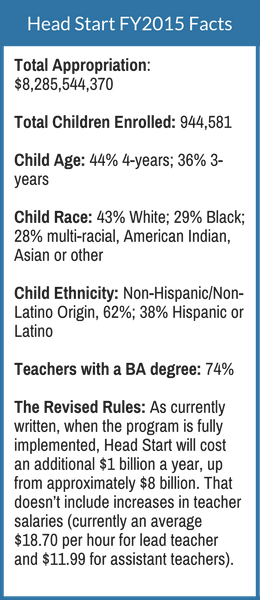What's the Research Behind Head Start's New Rules?
It’s been 40 years since the program performance standards were substantially revised for Head Start, the national program that has provided education and health support to millions of economically disadvantaged young children and their parents. Change came in September 2016, when a new set of program rules was approved and released.
These new rules will likely increase the cost of Head Start by $1 billion or about 12 percent, funds that Congress has not yet appropriated. To inform the ongoing discussion about this additional investment, here is some of the research behind the 2016 rule changes:
 1. Increased Duration and Exposure. The new rules require that Head Start programs expand children’s exposure to the program from a minimum of 3.5 hours a day for 128 days to 6 hours a day for 180 days. For programs that currently provide the minimum number of hours, this represents an increase of 140 percent in expected exposure to Head Start education services for the children they serve.
1. Increased Duration and Exposure. The new rules require that Head Start programs expand children’s exposure to the program from a minimum of 3.5 hours a day for 128 days to 6 hours a day for 180 days. For programs that currently provide the minimum number of hours, this represents an increase of 140 percent in expected exposure to Head Start education services for the children they serve.
AIR research shows that these increases in Head Start duration and exposure are consistent with state and local preschool practices across the U.S. For example, Susan Muenchow and Emily Weinberg found that local and state preschool programs they studied are open 175-190 days per year.
Research from the U.S. Department of Education’s Early Childhood Longitudinal Studies by AIR’s Jill Walston and Kristin Flanagan suggests that expectations about what children should know and be able to do in kindergarten have drastically changed over a 12-year span. Their research suggests that investments to get children “kindergarten-ready” are increasingly valued and expected, especially for economically disadvantaged children such as those eligible for Head Start.
2. Expanded Access. Head Start programs must now give priority to 3-year olds in the increasing number of communities that offer full-day public preschool for 4-year-olds.
Recent research finds ever increasing rates of public preschool attendance by the nation’s four-year olds (up to 40 percent as of July 2016). This creates opportunities for Head Start programs to serve more 3-year olds with high-quality early care and education. Although rigorous research is limited, well-designed observational studies suggest that two years of preschool starting at age 3 lead to better developmental outcomes than one year, especially for disadvantaged children.
And, according to my 2015 white paper, What Matters Most for Children: Influencing Inequality at the Start of Life, there is a wealth of research evidence to support education services for economically disadvantaged children even before age 3. Waiting until preschool to intervene with these children may be too late to close known gaps in their development and eventual school readiness.
3. Special Supports. Under the new rules, homeless children, foster children and English-language learners will have more qualified staff and research-based approaches to support their learning. These children represent a substantial share of Head Start’s target population. For example, AIR’s National Center on Family Homelessness reports that a historic high 2.5 million children are homeless each year (one in every 30 children in the United States). Fifty-one percent of these children are under age 6.
Young children and their parents who are homeless—or children removed from their primary caregivers—often experience toxic stress, which may interfere with their development and their ability to fully benefit from programs like Head Start, as evidenced in a 2014 study by Mary Dozier at the University of Delaware. The new rules intend to provide Head Start program staff with the resources to better serve these children and address their challenges.
4. Quality Teachers. The new rules encourage Head Start programs to replace intermittent teacher workshops and conferences with regular on-site teacher coaching to support individualized professional development and quality instruction. An AIR study on coaching in Head Start programs was one of several cited in the regulations to support the growing use of coaching for teachers’ professional development. This large, descriptive study found improvement over time in the quality of Head Start teachers’ instructional and behavioral management practices. Teachers also reported benefiting from ongoing coaching.
Head Start’s new rules align with the leading current research on child development and early education. Ensuring the adequate funding of the implementation of these rules is likely to benefit the children and families using the program, especially those who are most vulnerable.
Eboni Howard is a Managing Researcher at AIR with 25 years of experience in the areas of early childhood and family support, as well as program administration and management. She has served as a senior advisor, principal investigator, or project director for more than 40 projects and is nationally recognized for her expertise in early childhood development and use of mixed-method evaluation approaches.
